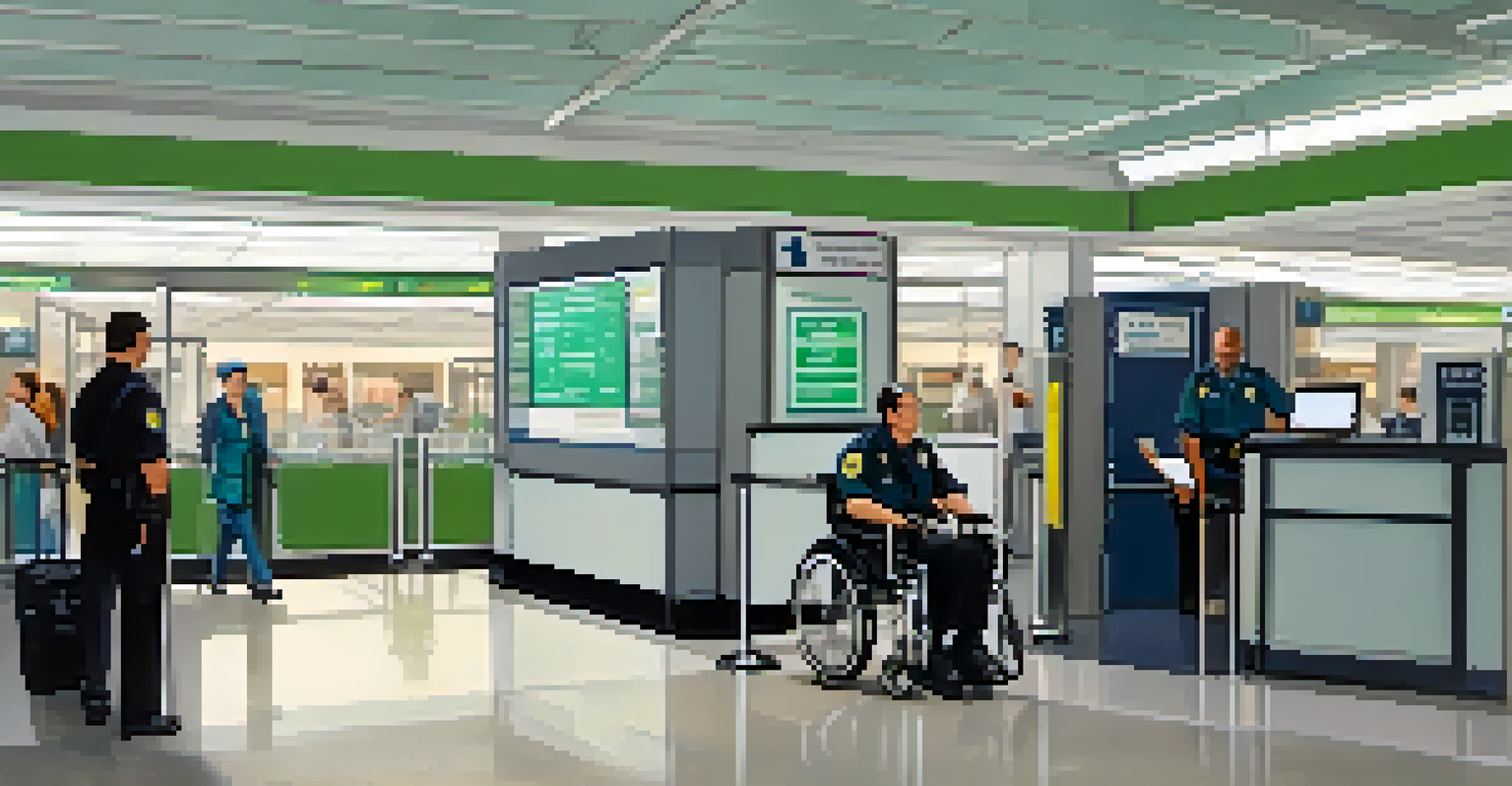Navigating Airports: A Guide for Travelers with Disabilities

Understanding Airport Accessibility Features
Airports are increasingly designed with accessibility in mind, offering various features to assist travelers with disabilities. These can include ramps, elevators, and designated seating areas. Familiarizing yourself with these amenities can significantly enhance your travel experience.
Traveling with a disability should not be a barrier to exploring the world; accessibility is a right, not a privilege.
For instance, many airports provide accessible restrooms and clear signage in multiple formats, including Braille. It’s helpful to check the airport's website or contact customer service to understand what specific facilities are available. Knowing what to expect can ease anxiety before you even arrive.
Additionally, many airports have dedicated staff trained to assist travelers with disabilities. These professionals can help you navigate the airport, ensuring a smoother journey from check-in to boarding.
Planning Your Arrival at the Airport
Arriving early is crucial for travelers with disabilities, as it allows ample time to address any potential challenges. Aim to arrive at least two to three hours before your flight, especially for international travel. This extra time can be invaluable in navigating security and boarding processes.

When planning your arrival, consider using accessible transportation options. Many airports offer shuttle services or specialized transport solutions for those with mobility issues. By booking these in advance, you can reduce stress and ensure a smoother start to your journey.
Know Your Airport's Accessibility
Familiarizing yourself with available accessibility features at airports can ease travel anxiety and enhance your overall experience.
It's also wise to familiarize yourself with the airport layout ahead of time. Most airport websites provide maps that highlight accessible routes, helping you plan your path through the terminal.
Requesting Special Assistance from Airlines
Before your trip, reach out to your airline to request any special assistance you may require. Most airlines have policies in place to support travelers with disabilities, including wheelchair services and priority boarding. It’s important to communicate your needs clearly when booking your ticket.
The journey of a thousand miles begins with one step, and for many, that step should be supported by accessible travel options.
For example, if you require assistance getting to the gate or help with your luggage, notify the airline at least 48 hours before your flight. This allows them to make the necessary arrangements and ensures there are no hiccups on the day of travel.
Remember, airlines are legally required to accommodate travelers with disabilities. Don’t hesitate to ask for what you need; they are there to help make your journey as comfortable as possible.
Navigating Security Checks Smoothly
Security checks can be a daunting part of air travel, but knowing what to expect can make the process smoother. Travelers with disabilities often have the right to request alternative screening methods if standard procedures are challenging. This might include a private screening area or assistance from security personnel.
It's helpful to arrive at the security checkpoint with any necessary documentation, such as a disability card or medical note. Being prepared can facilitate a quicker process and ensure that your needs are understood.
Plan for Smooth Travel Arrivals
Arriving early and using accessible transportation options can help navigate challenges more effectively and reduce stress.
Additionally, wearing shoes and clothing that are easy to remove can speed up your passage through security. Planning ahead for this part of your journey will help you maintain a sense of control and reduce stress.
Finding Accessible Gates and Amenities
Once you've cleared security, it's essential to locate your departure gate and any amenities you may need. Most airports provide information desks and staff members who can guide you. Don’t hesitate to ask for directions to accessible restrooms, lounges, or food services.
Many airports also offer quiet areas or lounges that provide a respite from the busy terminal environment. These spaces can be particularly beneficial for travelers with sensory sensitivities or those needing a moment to recharge.
Keep an eye out for charging stations and accessible seating near your gate. Being aware of your surroundings will help you feel more comfortable and prepared as you wait for your flight.
Boarding Procedures for Disabled Travelers
Boarding can often feel chaotic, but airlines typically prioritize travelers with disabilities. This means you may be invited to board before general boarding begins, allowing you extra time to settle in. Make sure to listen for announcements or check in with airline staff for guidance on when to board.
If you have a mobility device, such as a wheelchair, the airline will usually provide assistance. They may also allow you to board with your device and store it in the cabin if space permits. Understanding these procedures can help alleviate any stress or confusion.
Request Assistance from Airlines
Communicating your special assistance needs to airlines in advance ensures a smoother travel experience and compliance with their support policies.
It's also beneficial to have a travel companion if possible. They can assist you during boarding and ensure that all your needs are met, making the process less overwhelming.
Staying Comfortable During Your Flight
Once on board, comfort is key, especially for longer flights. Consider packing travel pillows, blankets, or any medications you might need during the journey. Inform the flight attendants of any specific requirements, such as needing assistance with meals or using the restroom, so they can provide help when necessary.
If you have dietary restrictions, notify the airline in advance to ensure suitable meal options are available. Most airlines will accommodate special meal requests when notified ahead of time.

Lastly, stay hydrated and move around during the flight if possible. Simple stretches or walking the aisle can make a big difference in how you feel upon arrival.
Arriving at Your Destination: What to Expect
As you land, make sure to prepare for disembarking. Airlines typically allow travelers with disabilities to deplane first, giving you a head start in navigating the airport. Knowing that you have this priority can alleviate any last-minute stress.
Once off the plane, follow the signs to baggage claim and customs. Most airports have staff available to assist if you need help getting to your next destination, whether it's a hotel or another flight.
Finally, don’t forget to provide feedback to the airline or airport regarding your experience. Your insights can help improve services for future travelers with disabilities, making air travel more accessible for everyone.